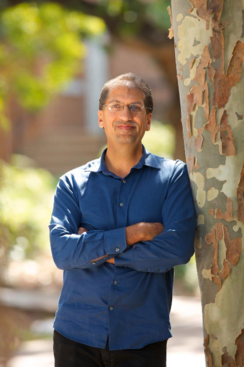
Frank Vahid has been using web-based teaching tools and incorporating online instruction into his courses since 2012. Vahid, a professor of computer science in the Marlan and Rosemary Bourns College of Engineering, believes students in STEM fields learn a lot by engaging with information presented in an interactive, visual format that depends less on text.
Along with Smita Bakshi, a former UC Davis professor, Vahid has developed web-native textbook replacements that depart from traditional “wall of text” electronic textbooks. These replacements, which they named “zyBooks,” use learning questions, animations, interactive tools, and embedded homework. Their company was recently acquired by textbook publisher John Wiley & Sons Inc.
Come-as-you-please vs. real-world simulation
When Vahid started his online offerings, there were no set schedules. There were optional discussion sessions and office-hours online.
“I thought that would benefit students by reducing scheduling conflicts,” Vahid said.
“We found that didn't work well. Students need to be part of something. They need a strong connection with the teacher, and fellow students, and need frequent high-quality interactions.”
Today, the online class is just like a physical class, except lectures and labs are held live using Zoom. “You just meet on Zoom instead of in class,” he said.
Online vs. textbooks
Vahid thinks physical classes are very important and should form a big part of the student and faculty experience. However, some online and hybrid classes can improve the college experience, for both students and faculty
He finds that many students learn better with online materials. The reason, he said, is that “textbooks are the learning paradigm of paper.” He said the web offers far more interactive learning.
“The ability to try something and get immediate feedback is hugely important to learning,” Vahid said. “Especially for lower-division classes, where students are younger, and need a lot of feedback to know if they are understanding things.”
Online materials can use animations to convey key concepts, which Vahid calls “the missing link in education.”
“Animations can convey a lot of information that static figures, or even writing on a whiteboard, cannot. I like to say that if a picture is worth a thousand words, then animation is worth five thousand.”
Vahid agrees there are advantages to the physical classroom. In-person instruction makes students feel involved, enables a strong connection between teacher and student, and helps students form friendships and working-studying relationships. “There's a strong social component to learning,” he said.
But online learning has its own unique advantages too, including a different kind of interaction via a chat box that students use during live instruction.
“They love that chat box, as it's much easier to just type a question than to raise your hand and stop everything,” he said.
Instructors can quickly poll students, keeping them engaged much faster than "clicker"-type questions in a physical classroom. Online meetings also reduce commute times, and students can attend even if sick, or if visiting their parents, or out of town for a wedding.
It's also easy to have guest speakers in an online class.
“I've had guest speakers from Silicon Valley pop in for 15 minutes. Students love such guest speakers,” Vahid said.
Student evaluations for online learning are positive, Vahid said, with many students preferring the interactive element of the online format.
The COVID-19 pandemic and online instruction
Vahid never foresaw a pandemic spurring universities to shift online.
“I knew online courses would become an increasingly useful complement to traditional courses,” he said. “And that online courses could be useful in the case of a local disaster, or a local flu season so students could learn from home, or a professor who was travelling but still wanted to teach, and so on.”
Vahid said many faculty resistant to online instruction who are now compelled to experiment with it may see its advantages. He sees the potential moving forward for more class sections offered online, as well as hybrids -- half online and half physical.




